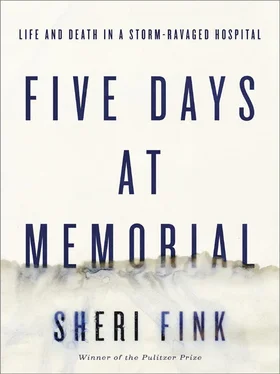Despite the request, and the fact that executives from some Tenet hospitals, like Atlanta, had already expressed a willingness to provide evacuation support, Tenet officials continued to rely on governmental resources to respond to the emergency.
BY MIDAFTERNOON, the waters around Memorial had climbed partway up the sloping emergency room ramp, where a camouflage-green National Guard troop hauler stood. Patients emerged from the ER, some pushed in wheelchairs, others using walkers, and were guided to the truck by hospital staff with sweat-soaked shirts and hair wet with perspiration. Anna Pou worked among them.
Pou and her colleagues loaded about a dozen people onto the open truck bed. They sat squeezed together along its sides on simple metal benches beneath a green metal frame. Hospital security personnel wearing blue bulletproof vests joined the effort to lift patients onto the chest-high platform. Several nurses climbed aboard to accompany the patients out of the city. One still wore her neat white tights despite the heat.
Beyond the truck, a man in a striped shirt waded along Napoleon Avenue in water up to his chest. One of the Memorial security guards walked atop the raised brick siding to the submerged end of the ramp. Gripping a traffic sign for balance, he leaned out over the water in the direction of the wading man and gestured away from the hospital. Even if the man didn’t hear what was said, the message seemed clear: he was being warned away from the hospital, not welcomed there.
The platform of the truck wasn’t much higher than the water level. A limited time remained to rescue patients by road.
At about four p.m., the truck’s large wheels churned through the water, rolled past downed crepe myrtle trees at the front of the old hospital building, and then headed west. Hospital leaders had arranged for the patients to be accepted at a hospital in Nacogdoches, Texas. They planned to send twenty-seven more patients there when a second truck arrived.

“IT’S TIME TO GO!” In the neonatal ICU, portable plastic bassinets, normally used to carry babies to their mothers’ rooms, were lined up on the ground with two babies each and their recent medical records. To the relief of the nurses, the NICU had not yet switched to computerized charts, which would have taken a long time to print and compile. A nurse’s husband sat in a chair cradling a skinny, diapered neonate against his chest to comfort it; one of its tiny brown feet stretched down to balance atop the man’s beer gut as someone snapped a picture. The man was one of many family members who were now volunteering with important nonmedical tasks.
The sickest babies were placed in transport isolettes—large, self-contained incubators on wheels complete with oxygen tanks, warming pads, and battery-powered pumps that administered IV fluids. The staff rolled one of them carrying two very sick babies to the single elevator working on backup power in the medical center’s newer Clara Wing. The incubator was too tall to travel through the garage on the back of a pickup truck, so staff pushed the wheeled machine up the parking garage’s down ramp, circling to the ninth story. Then five men in sweat-soaked T-shirts squeezed around the incubator and began to heave it up three sets of fire-escape stairs to the helipad. The machine that provided oxygen to one of the babies wasn’t working, so a nurse climbed the staircase beside the men, pushing oxygen from a small tank into the baby’s airways by repeatedly compressing a self-inflating bag the size and shape of a large lemon. She worked with a worried expression, her hand inserted in a round opening in the incubator.
When they reached the top, none of the expected Coast Guard helicopters awaited the babies. In the late afternoon someone at Memorial forwarded approach maps and geographic coordinates to a Coast Guard representative. Pilots from out of town were having trouble locating Memorial Medical Center. The helipad hadn’t been certified for use in years, and the markings indicating the old name of the hospital, Southern Baptist, could be confusing.
The babies waited for the Coast Guard helicopters in the covered tunnel, their incubators plugged into a power outlet supplied by a hospital generator. A neonatal specialist wearing green scrubs paced from the holding area to the helipad, growing increasingly worried as time passed. The babies were hot; one was having complications that might require urgent surgery. The neonatologist, Dr. Juan Jorge Gershanik, looked down at the water surrounding Memorial and imagined what it would be like if all power went out. The children would be goners. It would be a death sentence. He felt like he was in a movie.
He went to speak with internal medicine department chairman Richard Deichmann, who was outfitted with a two-way radio to communicate with other hospital employees as he directed movements on the helipad. Small private helicopters were landing, including one that dropped off the long-awaited drug supplies. Other pilots were willing to take sick elderly patients but not sick neonates, who typically required more specialized care.
Could Deichmann convince the pilots to transport babies instead? “We can’t wait any longer,” Gershanik said. “Please, Richard, see if any of them can take us.”
“I’m at their mercy,” Deichmann replied, but when another helicopter landed, he turned and gave Gershanik a pointed look. The neonatologist didn’t know what the look meant, but he rushed toward the helicopter, pushing the incubator ahead of him.
“No way,” the pilot said. The giant incubator couldn’t fit in his three-seat helicopter. The babies would have to wait.
“They can’t wait,” Gershanik said. More than an hour had passed on the helipad. It was getting close to sunset. “I really think they’re running out of time,” Gershanik said.
They were also running out of backup oxygen tanks on the helipad, and the nursery staff had to trek back into the hospital several times to get more. Some of the tanks went to elderly ICU patients also arriving on the helipad.
On the eighth floor in the ICU, nurse manager Karen Wynn, a blur of motion in wrinkled blue scrubs, was helping get them there. With the air-conditioning off for more than a full day and the ICU equipment producing heat, it was getting unbearable. The windows that hadn’t broken were sealed shut, some were still covered in plywood, and it was moist inside, humid. People were sweating. She told her staff they could change from their scrubs to shorts if they had them.
White box fans were moved back and forth between patients. Some in the unit weren’t terribly sick, but others were fragile and lacked resilience. The tiniest change in their environment threatened their homeostasis. The heat menaced them.
Wynn helped pry boards off of the inside of the windows, hoping to uncover cracked and broken panes that would let in some air. Male nurses and the housekeeping director took turns battering the windows Katrina had left intact with a tall metal pole normally used for hanging bags of intravenous fluid, finally shattering them.
When Karen Wynn put a patient on the elevator she heard a sound like Niagara Falls. The shaft was filling. A security guard stayed in the elevator to ensure that nobody pressed the button for the basement. Wynn wanted to get her patients off the eighth floor. Time was of the essence. Even if the generator power didn’t go out, they were going to have to shut down the elevator soon for safety.
The ICU had received a call for more patients on the helipad: “We need some more! Helicopters are waiting!” It was taking about forty-five minutes to get each patient to the helipad. Veteran surgical ICU nurse Cheri Landry, entrusted with the radio on the eighth floor, passed the word to her colleagues. “We’re losing helicopters, we have to move faster.”
Читать дальше













